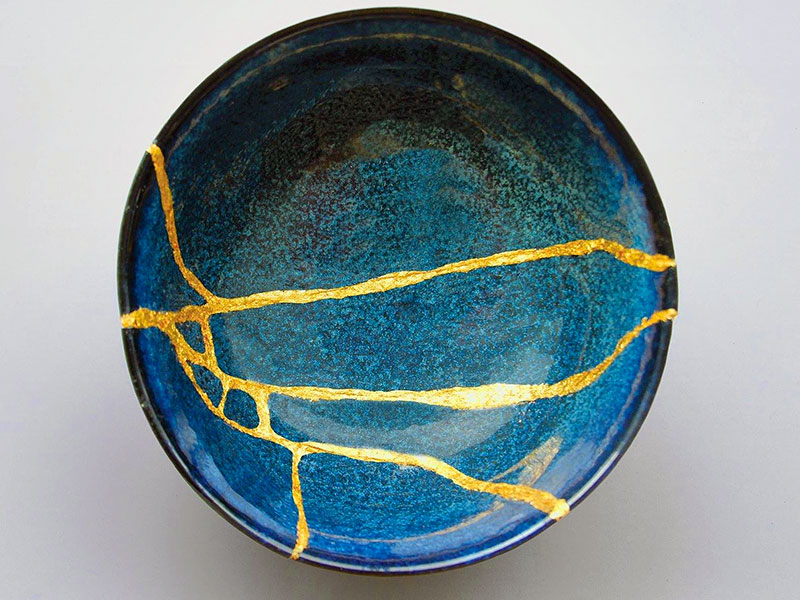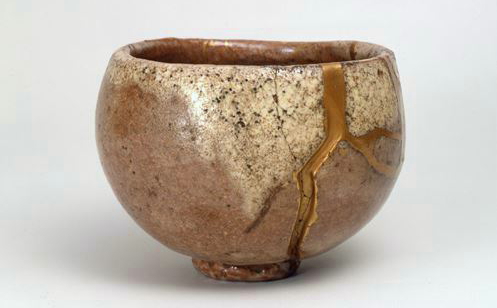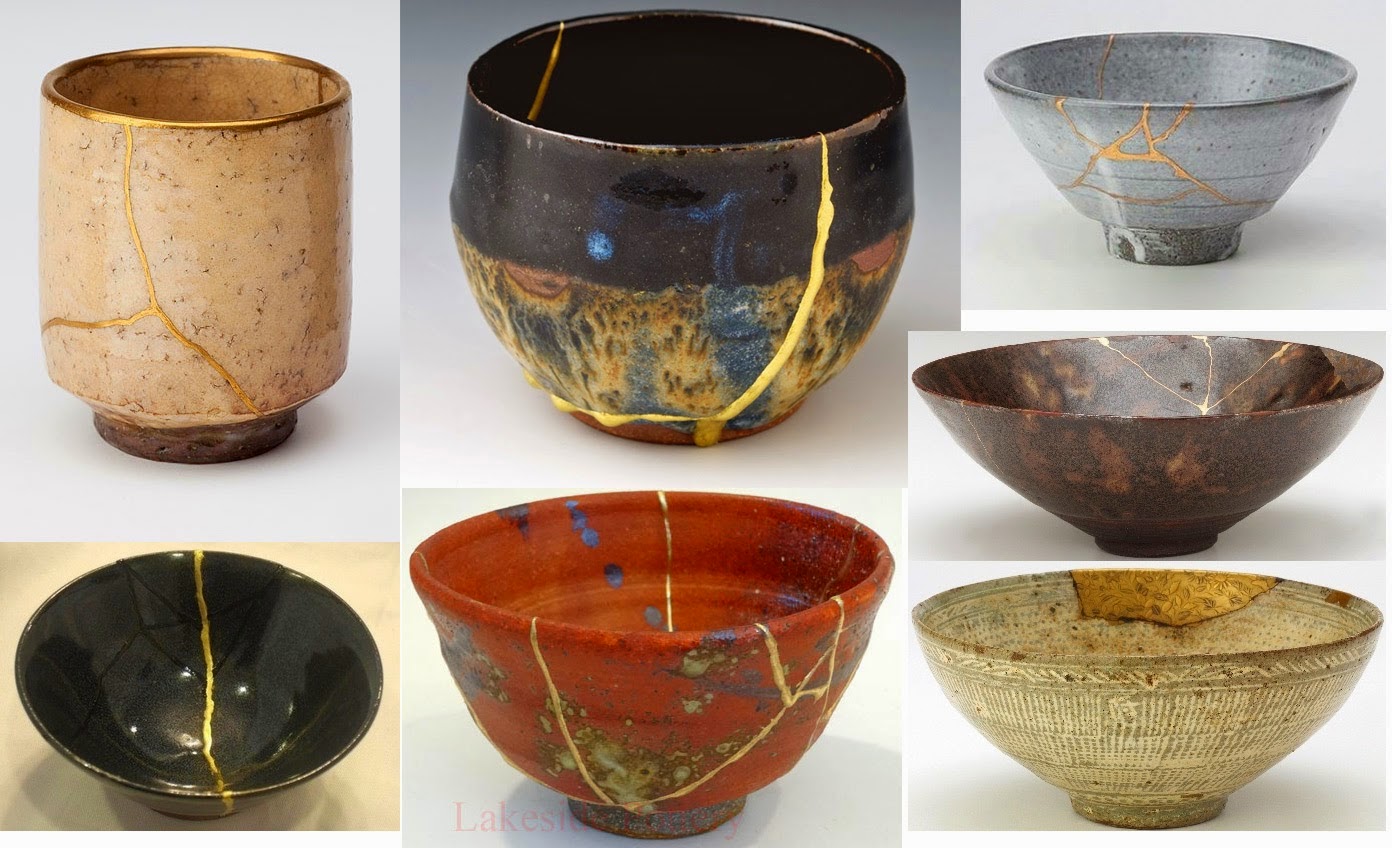Japanese Art keeps cropping up in our art threads. Amazing in itself, richly immersed in poetry and philosophy, Japanese Art has influenced artists all over the world. It's time we started a topic to explore all the wondrous things that Japanese artists have gifted the world, and the rich culture behind their art.
Let's start with Kintsugi, the art of mending with gold, and the philosophy behind it.
Kintsugi (金継ぎ, きんつぎ, "golden joinery"), also known as Kintsukuroi (金繕い, きんつくろい, "golden repair"), is the Japanese art of repairing broken pottery with lacquer dusted or mixed with powdered gold, silver, or platinum. As a philosophy, it treats breakage and repair as part of the history of an object, rather than something to disguise.
Kintsugi can also be seen to have similarities to the Japanese philosophy of wabi-sabi, an embracing of the flawed or imperfect.
Japanese Art
- NurseRatched
- Posts: 1923
- Joined: Sun Jul 30, 2017 3:30 pm
- Location: Middle of Nowhere, America
That is incredibly powerful!! Imagine if the world operated on this principle? Imagine if we viewed ourselves using this lens? Something to ponder. The cracks make the pottery miles more interesting!As a philosophy, it treats breakage and repair as part of the history of an object, rather than something to disguise.
Kintsugi can also be seen to have similarities to the Japanese philosophy of wabi-sabi, an embracing of the flawed or imperfect.
I think we've been practicing wabi-sabi all along & didn't know it
- Dee
- Site Admin
- Posts: 11027
- Joined: Mon Jul 10, 2017 12:52 pm
I think you're so right!
Wabi-sabi
Wabi-sabi (侘寂) is a world view centered on the acceptance of transience and imperfection.
"Wabi-sabi nurtures all that is authentic by acknowledging three simple realities: nothing lasts, nothing is finished, and nothing is perfect."
~ Richard Powell
The words wabi and sabi do not translate easily. Wabi originally referred to the loneliness of living in nature, remote from society; sabi meant "chill", "lean" or "withered". Around the 14th century these meanings began to change, taking on more positive connotations. Wabi now connotes rustic simplicity, freshness or quietness, and can be applied to both natural and human-made objects, or understated elegance. It can also refer to quirks and anomalies arising from the process of construction, which add uniqueness and elegance to the object. Sabi is beauty or serenity that comes with age, when the life of the object and its impermanence are evidenced in its patina and wear, or in any visible repairs.
In today's Japan, the meaning of wabi-sabi is often condensed to "wisdom in natural simplicity." In art books, it is typically defined as "flawed beauty."
Characteristics of the wabi-sabi aesthetic include asymmetry, roughness, simplicity, economy, austerity, modesty, intimacy, and appreciation of the ingenuous integrity of natural objects and processes.
In one sense wabi-sabi is a training whereby the student of wabi-sabi learns to find the most basic, natural objects interesting, fascinating and beautiful. Fading autumn leaves would be an example. Wabi-sabi can change our perception of the world to the extent that a chip or crack in a vase makes it more interesting and gives the object greater meditative value. Similarly materials that age such as bare wood, paper and fabric become more interesting as they exhibit changes that can be observed over time.
https://en.m.wikipedia.org/wiki/Wabi-sabi
Wabi-sabi
Wabi-sabi (侘寂) is a world view centered on the acceptance of transience and imperfection.
"Wabi-sabi nurtures all that is authentic by acknowledging three simple realities: nothing lasts, nothing is finished, and nothing is perfect."
~ Richard Powell
The words wabi and sabi do not translate easily. Wabi originally referred to the loneliness of living in nature, remote from society; sabi meant "chill", "lean" or "withered". Around the 14th century these meanings began to change, taking on more positive connotations. Wabi now connotes rustic simplicity, freshness or quietness, and can be applied to both natural and human-made objects, or understated elegance. It can also refer to quirks and anomalies arising from the process of construction, which add uniqueness and elegance to the object. Sabi is beauty or serenity that comes with age, when the life of the object and its impermanence are evidenced in its patina and wear, or in any visible repairs.
In today's Japan, the meaning of wabi-sabi is often condensed to "wisdom in natural simplicity." In art books, it is typically defined as "flawed beauty."
Characteristics of the wabi-sabi aesthetic include asymmetry, roughness, simplicity, economy, austerity, modesty, intimacy, and appreciation of the ingenuous integrity of natural objects and processes.
In one sense wabi-sabi is a training whereby the student of wabi-sabi learns to find the most basic, natural objects interesting, fascinating and beautiful. Fading autumn leaves would be an example. Wabi-sabi can change our perception of the world to the extent that a chip or crack in a vase makes it more interesting and gives the object greater meditative value. Similarly materials that age such as bare wood, paper and fabric become more interesting as they exhibit changes that can be observed over time.
https://en.m.wikipedia.org/wiki/Wabi-sabi
- NurseRatched
- Posts: 1923
- Joined: Sun Jul 30, 2017 3:30 pm
- Location: Middle of Nowhere, America
Exactly!! To quote you, "I love that shit!"  And I truly do...It's a beautiful thing.
And I truly do...It's a beautiful thing.
- Lori
- Site Admin
- Posts: 5550
- Joined: Sun Jul 09, 2017 11:08 pm
That is just great recycling, Petey! (*see Fantastic Mr. Fox)
It is a beautiful thing and poignant metaphor used lovingly once by a dear friend of mine who was actively helping me repair a valued relationship. At the time, I wasn't quite convinced that indeed the repair could happen at all let alone ultimately become more cherished than the original. I'm a believer now, and this art form holds a special place in my heart.
Applying to humans....here we go full circle again!

It is a beautiful thing and poignant metaphor used lovingly once by a dear friend of mine who was actively helping me repair a valued relationship. At the time, I wasn't quite convinced that indeed the repair could happen at all let alone ultimately become more cherished than the original. I'm a believer now, and this art form holds a special place in my heart.
Applying to humans....here we go full circle again!

- Dee
- Site Admin
- Posts: 11027
- Joined: Mon Jul 10, 2017 12:52 pm

How brilliant is this? I mean, it looks stunning and intriguing without any prior knowledge of Kintsugi, but once you know of it, you really get it. I love it.
Wabi Sabi is indeed a wonderful and freeing philosophy. I'm not entirely sure about the "nothing is finished" part, because I can think of many things that are. A puzzle can be completed. You graduate from a school. You sew up a button. You send a letter. A race is run. There are jobs that get done, and we can remove intention from carrying on, so an activity is finished (such as "I'm done with cleaning for the day") while I understand the concept "cleaning is never finished" applied to the needs of my house!!
- NurseRatched
- Posts: 1923
- Joined: Sun Jul 30, 2017 3:30 pm
- Location: Middle of Nowhere, America
"Nothing is finished", if taken literally, is the problem, is that what I'm understanding? I think that phrase is attributed to Richard Powell, who authored a book on the subject. It seems to be his interpretation, and many others have adopted his catch phrase. I've seen it in almost every article I've read! But I think you're right; certain tasks do get completed, but maybe that's focusing on minutiae. Maybe the phrase speaks more to cycles or broader meanings, like the seasons or learning. And does the phrase then dismiss the joy you feel in completing a task? Personally, I don't like the way Powell describes it, but it does simplify a big subject.
BUT, I think the nature of wabi-sabi is acceptance of all that. Yes, you've finished the puzzle, but allowed it to sit out on the table for months, while slowly the pieces come apart and get lost (like in my house). And you're OK with it! Yes, you've completed your degree & have an overwhelming sense of accomplishment, and you soak that in. Even though you have the awareness that now comes a lifetime of inservices, workshops and certification exams (the learning/growing never ends) Or remember the sand mandalas? The letting go?
Or remember the sand mandalas? The letting go?
I think this term is more of a feeling and an overarching aesthetic or philosophy, much harder to interpret or nail down.
"Wabi Sabi is the ancient Japanese wisdom of finding beauty in imperfection and simplicity in nature, of accepting the natural cycles of growth, decay, and death. Enjoying the simple, natural, and uncluttered, Wabi Sabi reveres authenticity above all. It celebrates cracks, chips, and other marks of time, weather, and use. Once we see the beauty in such “deficiencies”, we can learn to embrace the flaws—the wrinkles, rust, and frayed edges, and all the imperfections in our lives"-Nova Milesko
"Wabi-sabi is an intuitive appreciation of a transient
beauty in the physical world that reflects the
irreversible flow of life in the spiritual world. It is
an understated beauty that exists in the modest,
rustic, imperfect, or even decayed, an aesthetic
sensibility that finds a melancholic beauty in the
impermanence of all things."
Wabi-Sabi: The Japanese Art of Impermanence,
by Andrew Juniper
BUT, I think the nature of wabi-sabi is acceptance of all that. Yes, you've finished the puzzle, but allowed it to sit out on the table for months, while slowly the pieces come apart and get lost (like in my house). And you're OK with it! Yes, you've completed your degree & have an overwhelming sense of accomplishment, and you soak that in. Even though you have the awareness that now comes a lifetime of inservices, workshops and certification exams (the learning/growing never ends)
I think this term is more of a feeling and an overarching aesthetic or philosophy, much harder to interpret or nail down.
"Wabi Sabi is the ancient Japanese wisdom of finding beauty in imperfection and simplicity in nature, of accepting the natural cycles of growth, decay, and death. Enjoying the simple, natural, and uncluttered, Wabi Sabi reveres authenticity above all. It celebrates cracks, chips, and other marks of time, weather, and use. Once we see the beauty in such “deficiencies”, we can learn to embrace the flaws—the wrinkles, rust, and frayed edges, and all the imperfections in our lives"-Nova Milesko
"Wabi-sabi is an intuitive appreciation of a transient
beauty in the physical world that reflects the
irreversible flow of life in the spiritual world. It is
an understated beauty that exists in the modest,
rustic, imperfect, or even decayed, an aesthetic
sensibility that finds a melancholic beauty in the
impermanence of all things."
Wabi-Sabi: The Japanese Art of Impermanence,
by Andrew Juniper
- Dee
- Site Admin
- Posts: 11027
- Joined: Mon Jul 10, 2017 12:52 pm
Thanks for chewing this issue of "nothing is ever finished" over with me, NR. 
In response to my listings of practical things being finished, you say...
In response to my listings of practical things being finished, you say...
Yes, you're most certainly right. We never stop learning, loving, cleaning, questioning...everything continues, on a cycle or otherwise. Looking at the minutiae: "you've sewed up a button" "you've got a degree" "you've completed a puzzle" is promptly followed by the question "then what?" Move onto the next thing. You can never stop. And it's the doing the next thing that is the point, the journey, the engagement, not what we have achieved already. The only thing that is truly important is what we are doing right now, and we will always be doing something or in pause briefly between doing things. Just thinking out loud here."maybe that's focusing on minutiae. Maybe the phrase speaks more to cycles or broader meanings, like the seasons or learning.
-
- Information
-
Who is online
Users browsing this forum: No registered users and 3 guests




